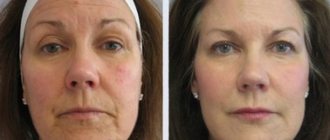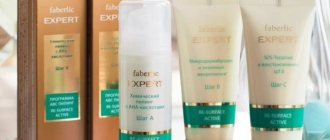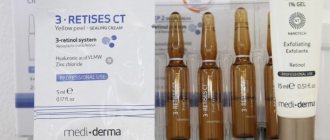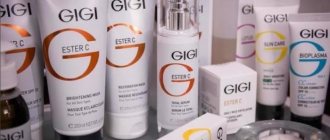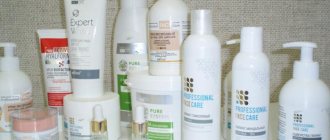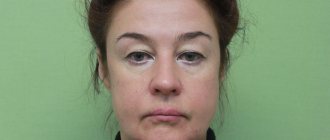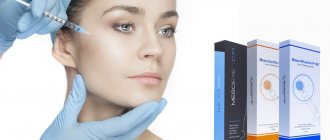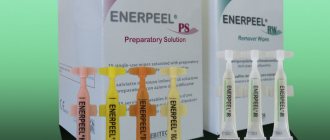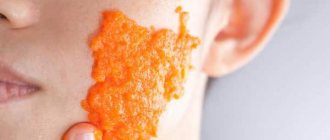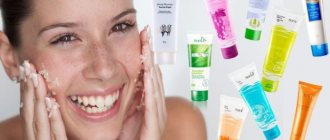Line of multi-acid peelings MG Peel System
The MG Peel System line of professional multi-acid chemical peels was created to correct aesthetic skin problems as part of complex procedures in beauty salons and medical clinics.
Indications for the use of multi-peelings
- Photoaging
- Chronoaging
- Shallow wrinkles, including “crow’s feet” in the eyelid area
- Hyperkeratosis
- Violation of skin microrelief
- Seborrhea
- Enlarged pores in the T-zone
- Acne
- Post-acne
- Hyperpigmentation
MG Peel System peels are superficial. At the same time, they provide targeted, targeted correction of a specific problem and a good visible result after the first session. The maximum result is achieved after a course of procedures.
The concentration of acids in multi-peelings is from 5 to 40% at pH 3
. Thanks to this pH level, acids penetrate the skin more slowly, without causing an acute reaction or complications. And it’s easy for a specialist to control the process, monitor the reaction of the epidermis and get the desired result.
Each product in the line is carefully thought out and ideally balanced in terms of the composition of the acids in the complex and the mechanism of their work. Acids in multi-peelings vary in molecular size, depth of penetration into the skin and intensity of impact. Working together, they complement and enhance each other's properties, allowing you to achieve impressive results in a short time.
The gel texture guarantees comfort during work for both experienced specialists and novice cosmetologists. The peeling is easily applied to the brush and distributed over the skin without spreading.
MG Peel System allows cosmetologists to select the optimal peeling individually for each client, depending on the type and condition of the skin, aesthetic problem, time of year and the desired result. And all this is within one line.
Multi-acid peels, even at a concentration of 40%, act on the skin as gently as possible. The risk of complications and adverse reactions (burns, severe hyperemia, frost, severe peeling) is minimized. If the cosmetologist follows the procedure protocol, the client can go to work or an event immediately after peeling. Despite this, multi-peelings are strictly professional preparations
and are intended for specialists who can determine the skin's reaction to acid and guarantee the safety of the procedure.
Peeling neutralizer at home
The obvious advantages of dry cleaning based on fruit, citric and lactic acids are:
- rapid and effective results for all skin types;
- gentle effect on fabrics;
- short rehabilitation period;
- availability of components;
- low price.
And most importantly, the ability to carry out the procedure at home without loss of quality. A prerequisite for self-cleansing your face is to observe the process in front of a mirror in order to timely prevent unwanted consequences.
The essence of a peeling neutralizer at home is based on:
- on eliminating skin problems after dry cleaning;
- to accelerate the process of tissue restoration;
- stopping further exposure to aggressive substances included in the peeling.
After all, the chemical components do not immediately “calm down” and continue the reaction for another 3-4 days. Timely neutralization of synthetic drugs contributes to faster and less painful subsequent restoration of the facial skin.
The most common at-home peeling neutralizer is a baking soda solution, which is prepared in advance to save time by preventing prolonged exposure to chemicals on the skin.
For 150 ml of water take 1 tsp. soda and mix everything thoroughly. Apply the alkaline mass with a cotton swab to the treated areas.
The time spent on the skin of the face lasts about 2-3 minutes and is accompanied by hissing and the appearance of small bubbles. Then the reaction residues are removed with warm water. Gently blot your face with a soft cloth using absorbent movements and apply moisturizer.
A strong solution of medicinal chamomile will help to cope with the consequences of superficial peeling procedures.
Peeling gel ANY-Time Control
The most delicate line peeling. All-season, does not cause photosensitivity, can be used during the season of high solar activity. Suitable for sensitive skin. Best suited for oily problem skin.
- Acids
: salicylic, mandelic, lactic. - Concentration and pH
: 5%, pH 3. - Volume
: 100 ml. - Indications
: photoaging, chronoaging, shallow wrinkles, hyperkeratosis, seborrhea and hyperpigmentation. - What it does
: balances the activity of the sebaceous glands, reduces skin oiliness, deeply cleanses pores, fights comedones, acne and post-acne, moisturizes, brightens.
Ingredients (INCI):
Aqua, Ethoxydiglycol, Salicylic acid, Mandelic acid, Sodium Lactate, Hydroxyethylcellulose. BUY >>
With calcium chloride
Calcium chloride can be purchased at a pharmacy. To prepare a homemade peeling, you will need an active substance and baby soap. It should be taken into account that the calcium chloride solution can be of different concentrations - 5 or 10%. The first option is suitable for softer peeling. For deep cleansing of the skin, it is recommended to choose a concentration of the active substance of 10%.
Algorithm:
- The face is thoroughly cleansed and any remaining makeup is removed.
- The solution is applied to the skin in several layers.
- A layer of soap is applied on top of the calcium chloride.
Dead skin cells will slough off easily, eliminating blackheads and unclogging clogged pores. After peeling, you need to wash your face with warm water and apply a nourishing cream.
Peeling gel KERATO-Skin Control
Universal peeling for all skin types. Use independently and as a preparation step for medium peels. Can be used in the eyelid area.
- Acids
: glycolic, salicylic, citric, lactic, malic, tartaric. - Concentration and pH
: 35%, pH 3. - Volume
: 100 ml. - Indications
: hyperkeratosis, uneven microrelief, seborrhea, post-acne, photoaging, wrinkles, hyperpigmentation. - What it does
: intensively exfoliates, renews, regenerates, smoothes, moisturizes, brightens.
Composition (INCI)
:
Propyleneglycol, Glycolic Acid, Aqua, Salicylic acid, Sodium lactate, Glycerin, Citric acid, Lactic acid, Malic acid, Tartaric acid, Citrus medica limonum (lemon) fruit extract, Pyrus malus (apple) fruit, Saccharum officinarum (sugar cane) extract, Vaccinium myrtillus extract, Vitus vinifera (grape) fruit extract, Hydroxyethylcellulose. BUY >>
Reviews from women
Many ladies who have tried acid pedicure at home note the intensity of the effect and do not recommend resorting to it often. You need to choose a product for home use very carefully, do not chase the speed of exfoliation, but it is better to stick to those that last longer, but are gentler. Professional products require a professional approach, otherwise they simply become dangerous.
There were no unpleasant sensations when exposed to the skin. After use, the skin is soft, I removed small calluses the first time, but I didn’t do anything with dry heels and cracks on them. The composition contains alkali, so be careful if it gets on more delicate areas (ankles) it can leave a burn with prolonged exposure . This happened to me, and the gel accidentally got on my ankle, right in the place where the bag was tied. After washing it off, a wound appeared in this place.
Elena Faberlik
https://irecommend.ru/content/ne-dlya-zapushchennykh-sluchaev-khorosho-deistvuet-tolko-na-predvoritelno-podgotovlennykh-no
My conclusion is this: acid pedicure is heavy artillery. It’s good to do it when the legs are already very neglected, when it’s difficult to help there with a file. I really don't recommend using it all the time! Maximum once a quarter or even every 6 months. After a year of use, my legs became a little worse, cracks and grooves appeared - it's all acid. When I stopped doing this type of pedicure - and switched to oils and socks at night - my legs became even better than before the acid treatment)))
TV-ukr
https://irecommend.ru/content/v-pogone-za-rozovymi-pyatochkami-kislotnyi-pedikyur-v-domashnikh-usloviyakh-moi-oshibki-rezu
Acid pedicure is a modern alternative to using rough graters and heel files. In this technique, the feet are cleaned using a special gel, which is commonly called a liquid blade. The acid pedicure procedure can be both a real salvation for your feet and a test. But if a specialist gets down to business, there is nothing to be afraid of.
During the home facial exfoliation procedure, women are faced with the use of a peeling neutralizer at home - a product for complete post-peel care. This rule, however, applies not only to home peeling, but also to salon peeling - the master is unlikely to cross out the point of applying a neutralizing composition from the protocol of the cleansing procedure. What are these post-pilatory agents and what effect do they have? Is there an alternative to store-bought peeling neutralizers - homemade formulations created with your own hands? And if there is no suitable neutralizing composition at hand, is it possible to replace it with something?
Peeling gel REPAIR-Skin Control
Peeling for mature skin. Use independently and as a preparation step for medium peels. Can be used even on the thinnest and most sensitive skin, as well as in the eyelid area and “crow’s feet”.
- Acids
: gluconic, glycolic, succinic. - Concentration and pH
: 40%, pH 3. - Volume
: 100 ml. - Indications
: chronoaging, photoaging, wrinkles, hyperpigmentation, post-acne. - What it does
: evens out microrelief, stimulates collagen synthesis, smoothes, increases skin turgor, moisturizes, regenerates.
Composition (INCI)
:
Aqua, Glucino delta lactone, Gluconic acid, Glycolic Acid, Arginine, Succinic acid, Hydroxyethylcellulose. BUY >>
Contraindications to the peeling procedure
- Individual intolerance to the components of glycolic peeling with a neutralizer; increased skin sensitivity;
- skin disorders (wounds, scratches, irritation, peeling, etc.);
- acne in the acute stage;
- herpes in the acute stage;
- warts and other neoplasms;
- hair removal, fresh tanning, use of retinoids shortly before peeling;
- acute respiratory and viral diseases;
- increased body temperature;
- pregnancy and breastfeeding;
- recent course of hormonal or chemotherapy;
- oncological diseases;
- hypertension;
- diabetes;
- bronchial asthma.
Special instructions and additions
After peeling, it is not recommended to: visit the sauna and solarium, stay in the sun for a long time, use care products that dry the skin or have an irritating effect.
Since peeling is an exposure to 35% acid, after the procedure the following are possible: slight redness (from 2 hours to 1 day) and peeling of the upper layer of the epidermis. It is necessary to use moisturizing and nourishing post-peeling care products to the maximum. With high skin sensitivity and (or) long exposure time, the formation of crusts and ulcers is possible. In this case, it is necessary to reduce the concentration, exposure time or abandon the subsequent use of glycolic peeling.
Release form : 2 bottles of 60 ml
How to buy? In order to buy Glycolic Peeling with Neutralizer, art. 1171 (produced by Marianna - riciniol) at a price of 725 rubles. in Moscow or any other region of Russia - you just need to place an online order on the website or place an order by calling and we will deliver Marianna - riciniol products to you as soon as possible.
Attention! This product is a dietary supplement or health product and is not a medicine. Consult your physician before use.
Properties of glycolic peeling
Peeling based on glycolic acid has a gentle effect on the epidermis. The procedure triggers cellular regeneration, causing the skin to become fresh, smooth and rejuvenated. Glycolic acid works as follows:
- Improves blood circulation, promoting rapid skin restoration.
- The structure of sebaceous plugs is destroyed due to the action of A-HA acids. This helps get rid of common skin problems such as milia and comedones.
- Helps prevent hyperpigmentation by evenly distributing melanin.
- It has a rejuvenating effect at the cellular level by stopping the destructive processes of withering.
Glycolic acid is found in beets, sugar cane and grapes. It also brightens the skin and reduces the appearance of age spots and freckles.
Important! After using glycolic acid, you need to protect your skin from sunlight, otherwise the effect will be exactly the opposite.
With activated carbon
Homemade activated charcoal peeling helps cleanse the skin of stagnant oil, dirt and harmful bacteria. After this procedure, the number of blackheads decreases, the skin becomes cleaner and fresher.
Classic peeling option:
- A pack of activated carbon is ground into powder and mixed with a small amount of water. The result should be a black paste.
- Apply the finished product to problem areas. The skin needs to be massaged a little.
- Leave the composition for 10 minutes, rinse with warm water.
This option is perfect for oily and combination skin. If you are prone to dryness, it is recommended to replace water with milk, and you can use full-fat sour cream as an additional component.
An excellent replacement for expensive professional peelings are home treatments. To get the desired effect, you need to carry out the procedures in courses. The number of manipulations depends on the composition of the product, the type and initial condition of the skin.
How to care for your skin after peeling
Many people note that after home peeling, the skin begins to peel. This reaction is completely normal, but it is necessary to take care of the skin so that it becomes smooth again. Nourishing masks and moisturizers will help with this. You can also prepare them yourself, but if you don’t have time, then regular sour cream will do.
Do not use scrubs or try to tear off pieces of skin. Such an intervention will lead to the formation of small wounds, so it will no longer be possible to continue the peeling course.
Experts do not recommend peeling during periods of high sun activity. This time is from early April to mid-October. If the decision was made to resort to the procedure, you will have to take care not only of classical care, but also of other protection.
It is necessary not only to completely avoid sunbathing on the beach or in a solarium for several weeks, but also to replace the usual cream with a product with an SPF factor (so that the protection index is at least 30). In winter everything is much simpler. Instead of special protection, you can use color-correcting cream or regular powder.
You can perform one peeling procedure based on glycolic acid every month, this will help prolong the positive effect. But a repeat full course is done no earlier than after 6 months.

